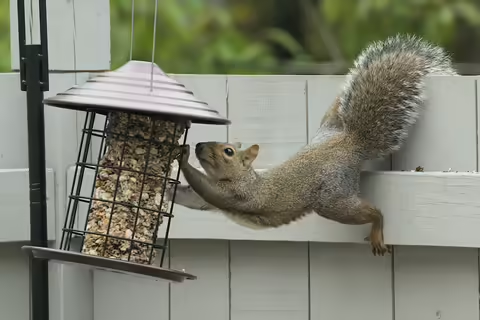What is an annoying animal encounter?
An annoying encounter is merely inconvenient. It poses little or no hazard to your health and can usually be resolved with a gentle approach, a touch of tolerance, or a little patience. These include bugs, harmless snakes, and moles.
Explore Everyday Encounters Explore Risky Encounters Explore Dangerous Encounters
Something is digging in my yard...
Rodents, moles, armadillos, and crayfish create holes in our yards, which can actually aerate and mix soil, improving drainage and creating habitat for other animals. Still, these holes are annoying and can be trip hazards. Woodchucks or groundhogs create large holes but can be excluded with care.
Something is chewing on my house...
The most likely culprit is a mouse, squirrel, or groundhog, all rodents that love to gnaw with their sharp incisors. If exterior, chewing likely poses no risk to your health. However, if animals are chewing inside, you may have an infestation of mice or rats, which you should investigate.
There's a squirrel on my birdfeeder...
A birdfeeder, clearly in its name, is meant to feed birds, not squirrels, so a squirrel hogging the seeds and chasing off beautiful birds can be annoying. However, squirrels pose a threat to neither humans nor the birds in the yard, as the birds surely know of other places to find food. Consider buying an anti-squirrel bird feeder and hanging it where squirrels cannot climb or jump onto it.
There’s a spider in my house...
Most of the time, this is good news because spiders eat other pesky arthropods like ants and flies.
Only two spiders in Illinois pose serious risks to most people – the brown recluse and the black widow. The brown recluse can be a common uninvited houseguest in southern Illinois but is rarely a cause for concern because they like to stay hidden.
Deer are eating my garden...
Your beautiful garden plants being eaten by deer can be a major annoyance, but deer pose very little risk to you or your pets. Deer will always need to eat, but they can jump up to 8 feet vertically, so exclusion fences may not be effective. Making plants unappealing with anti-deer sprays or choosing unappealing plants, such as replacing hostas with purple coneflower, may be your best option.
There's a snake in my yard...
Most of the 38 snakes that occur in Illinois are harmless and eat insects, frogs, or small rodents. It’s unlikely you’ll see one of the state’s four venomous snakes (the eastern copperhead, northern cottonmouth, timber rattlesnake, and the massasauga) in your yard because they tend to enjoy large tracts of forest or prairie habitat. If you spot a snake lounging in your yard, snap a photo from a safe distance and use tools like Seek or Google Lens to confirm the identification. Learn what to do if you are bitten by a venomous snake.
A raccoon stole my suet...
Raccoons are sneaky and tend to skulk off with stolen objects left in the yard after sunset. Use zip ties or paracord to secure your suet feeder, or bring it in for the night. Keep bird and pet food sealed and out of reach for rummaging raccoons to discourage them from hanging out by your house.
Something is banging on my gutters or siding...
Birds sometimes peck at wood siding or trim, or they bang on windows to attack their own reflection. These could be annoying territorial behaviors, or birds might be drilling holes to create roosting spaces or to search for food. Shiny streamers or other reflective objects sometimes scare birds away. Marking the outside of a window with paint, tape, soap, or film will help birds recognize windows as glass and not be so confused by their own reflection.
There’s a bug in the house...
Most insects that wander into your home are completely harmless and can be safely escorted back outside. Common and harmless intruders include ladybugs, crickets, stinkbugs, boxelder bugs, and the many moths that linger around the lights at your front door. The best way to decrease bugs in your house is to seal off cracks, clean up food and crumbs left on counters and floors, or even allow spiders to survive in your house, as their prey are household bugs. Cockroaches, bed bugs, and insects infesting your food are a different story; check our risky encounters section for information on these pests.
There’s a opossum under my deck...
Opossums are rarely a cause for concern, and in fact, these secretive animals benefit people by consuming small mammals and arthropods. Their natural daytime dens are hollow logs or trees, which makes the areas underneath buildings appealing. Opossums occasionally get into bird feeders or garbage. Keep them away by removing attractive features or through exclusion.
Explore some of the problems humans may encounter when an animal shows up in our yards with Extension wildlife expert Peggy Anesi. We talk about what is the most destructive wild animal and ways to minimize their efforts to eat our landscapes as well as conservation efforts that can be done in...
Wildlife can be fun to watch, but wild animals can also be very destructive to the home landscape. The Good Growing team discusses damage from deer, rabbits, raccoons, squirrels, voles, and mice and tips to help coexist and protect your landscape.
At Extension, we help people find solutions to life's challenges. Connect with Extension staff in your area for research-based information and solutions. Extension staff on the natural resources, environment, and energy team focus on issues related to wildlife and human and wildlife interactions.
